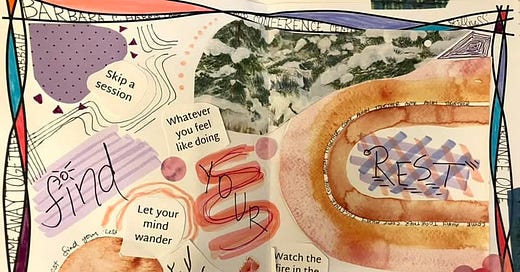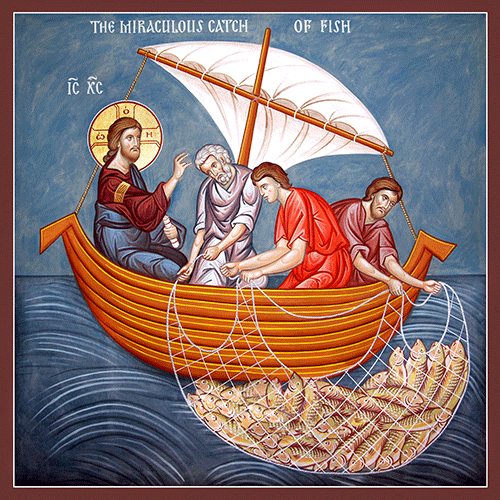Dear Friends,
I hope you all enjoyed last week’s interview with Natalie & James Thomas of Bedtime Chapel. I had such a great time chatting with them and I can’t recommend their podcast enough. If you were “at” Forma last week and missed that interview, go back and check it out here.
I was, indeed, at Forma last week, co-hosting one of the Provincial gatherings that took place across the United States. It was a total blast! I knew a lot of the folks gathering at Barbara C. Harris Camp & Conference Center, particularly from online coordinating, but it was great to really get to know my regional community in person. We’re going to have some big schemes together.
For those outside of the Forma bubble (which, while technically an Episcopal organization, had participants from 10 denominations this year), our conference theme was “Come Away Together,” with a focus on ideas about rest, retreat, and sabbath. And even as one of the site coordinators, there really was so much rest. It was also really conflicting to be so apart from the world as so many painful things were coming up in the news. I would glance at the internet once or twice a day and feel lost. But it was also a good reminder that we are going to need rest, retreat, and sabbath all the more in the months and years to come.
Tales Of Abundance
Part of what was so much fun about my contingent of the Forma gathering – I don’t know what other sites’ prayer practices looked like (but I’d love to hear about them) – it that, while we read the “Come Away Together” guiding text from the Gospel of Mark each morning, during evening prayer, we would read the gospel from the day’s lectionary, which were in fact the passages immediately preceding that guiding passage. But, the thing that is at the heart of the guiding passage is that, while Jesus calls the disciples to come and rest, that rest quickly is overtaken by the needs of the crowds, leading to the feeding of the 5000 – despite having just 2 fish and five loaves of bread.
This week’s gospel reading from Luke brings us into a similar space of abundance. Here we encounter the famous “fishers of men” story, but it’s important to remember that those words follow Jesus manifesting an overwhelming quantity of fish for the disciples who had spent a whole night working and yet had caught nothing. Suddenly there were more fish than their nets could bear.
These stories of abundance invite us into a question: what does it mean to have enough? What about too much?
And, what do we do when we have too much?
Abundance, Excess, & Modernity’s Problems
The other day I listened to a New York Times interview (gift link) with the author and psychiatrist, Dr. Anna Lembke and I honestly think this is a must-read/listen interview (it’s a live recording with Dr. Lembke and the intervierwer, Lulu Garcia-Navarro) for everyone, but especially for anyone raising or working with young people. Lembke is a dual-diagnosis specialist, meaning she works with patients who have both mental illness and addiction diagnoses, but NYT spoke to her particularly about how our brains experience our contemporary relationship with technology, what we’re actually biologically “designed” for, so to speak, and why we’re so drawn to both technology and other “substances” in this particular moment.
One of the phenomena that Lembke describes is that of overabundance as a symptom of living in the anthropocene - the era in which human behavior is changing the natural world in dramatic ways. As she explains:
“In the richest countries in the world, we have more leisure time, more disposable income, more access to leisure goods than ever before. And as a result, we are all struggling to know what to do with all that extra time and money. And one would hope and think that we would be engaging in deep philosophical discussions, helping each other… essentially what’s happened is we’re spending more and more of our energy and creativity investing in this online world, which means that we are actually leaching our real-life existence of our energy and creativity. So when we try to re-enter the real world, it actually is more boring, because there’s less going on, because there’s nobody there.”
If you’ve ever wondered why it’s so hard to get anyone together IRL, there’s a big piece of the story! We’ve literally shifted our supposed community investments. Why go into a flat, boring world when our lives are in the digital space behind the screen?
The other part of this interview that really struck me was this passage:
“I think we’re essentially struggling with endemic narcissism, where our culture is demanding that we focus on ourselves so much that what it’s creating is this deep need to escape ourselves. And I think that is what is driving much of our pursuit of intoxicants as a way to just not have to think about ourselves for a blessed, you know, hour or two.”
Jesus and the disciples didn’t have cellphones to get messages to the next town. They couldn’t spend the night waiting for the fish to come in while playing Candy Crush Saga. They had to talk to each other. They had to ensure they had what they needed for their journeys. They had to make connections everywhere that they went. It’s not that it was easier to live that way, but it was life on the scale our cognitive systems were designed for.
When Jesus and the disciples experienced abundance, it was of the sort that was of service to others. It was too much bread and too much fish. It was abundance in essentials. When we experience abundance in essentials, like too many canned goods stacked up in the closet, we may not have the social connections to share them anymore. I can’t drop some soup into the group chat.
Abundance can be glorious. It can provide security. It gives us the opportunity to share and care for each other. But the wrong kind of abundance can also turn us inward. And then, because we have turned too far inward, we turn back to soothing technological black holes to escape ourselves.
Returning to the beginning of this message about Forma and our emphasis on rest, retreat, and sabbath – and the ways in which those might all be distinct – the abundance of easy, technological escape can be a barrier to all of the above. While we can certainly use technology to access prayer and worship practices that bring us closer to God (sabbath), it’s more often our habit to use them as false modes of rest or retreat. To say, oh, I’ve done what I need to do today, now I can rest – and then to get on our phones instead of actually finding a still place in ourselves. Or to feel overtaxed and to flip open a YouTube video or a phone game as a mode of retreat (escape).
If we want to step back from the nonstop world, to connect with ourselves and with God, part of that process is putting away the technology. It’s taking that road trip with no tech (except maybe Google maps). It’s wearing a watch instead of checking our phones. It’s leaving our phones in another room at dinner or in our jacket pocket at parties with friends. It’s reading aloud together or playing board games or going on walks. It’s making space in our lives where those excesses can’t intervene and we can get back to a more natural baseline.
We want a net full of fish and a circle of friends and family to share it with around the fire. Instead, we’ve got a bag of chips, a locked door, and a dozen flashing lights. It’s no wonder we all feel like we’re hanging by a thread – but it only changes if we decide to change it together.
Resource Round-Up
We’re really arriving in the middle of Epiphany, which means it’s time to get those Lent plans in order!
Illustrated Ministry has such a wide variety of Lenten devotionals for families and parishes. Given my druthers, though, I might opt for their Ash Wednesday labyrinth meditation and use that as a tool for structuring an extended series of simple, embodied prayer practices. Learn to make your own labyrinths out of different materials, large and small. Explore prayer beads and centering prayer and prayer walks. Keep it simple.
I’ve built some pretty ambitious programs over the years, but this year I think with my upper elementary-adult contingents, I might go the Lent Madness route. The bracket posters are available to order, as is this year’s Saintly Scorecard. I think learning about the variety of Holy People included in Lent Madness is always a lot of fun, plus the bracket system really encourages sustained participation. The last few years I’ve felt like there were a few ringers in there, but this year’s lineup feels a little more even. My little Lutheran heart is calling out to Katharina Zell, but Lucy of Syracuse is one of my long-term favorites – and really anything could happen!
Last year I build a program based on Gayle Boss’s Wild Hope. This beautiful book is such a great anchor for older kids who are really interested in the animals and the environment, but also has a lot in it for adults. I may go back to those materials and create a packet for others to access this program (we’ll see how my bandwidth is!).
Twas the Season of Lent by Glenys Nellist is half-off on ChristianBook.com right now, and don’t forget that now we have not only Make Room, Laura Alary’s Lent & Easter book, but also Rise, the new Eastertide volume in that series. I still need to grab my copy of Rise.
Off the Lent line for a moment:
I’ve talked about how much I love Mollie Donihe’s Visio materials here before and she’s got a brand new resource, developed with Elizabeth Caldwell (of the Growing in God’s Love storybook Bible) and her husband Ryan. This new Checking In Deck draws on the Four Forces of Spirituality by Gerald May and is designed to support meaningful reflection and introspection on the part of young people in regards to their spiritual lives – and of course it features Mollie’s beautiful quilt designs. I’m sure us grownups will get a lot out of it too.
Finally, I’m really excited to grab a copy of Valerie Ellis’s new children’s storybook, “Let’s Go! Bible Adventures,” which is out today. This book inserts kids’ favorite vehicles into core Bible stories, exploring what really happened but opening up these stories to the world of what if? What if Adam & Eve had a tractor? What if Mary & Joseph could have driven to Bethlehem in the family sedan? For all those vehicle loving little ones, this is THE book.
That’s all for this week. I hope you’re feeling inspired to think about the question of abundance. More than in most moments, the world needs us to serve from our places of abundance right now.
Peace,
Bird






